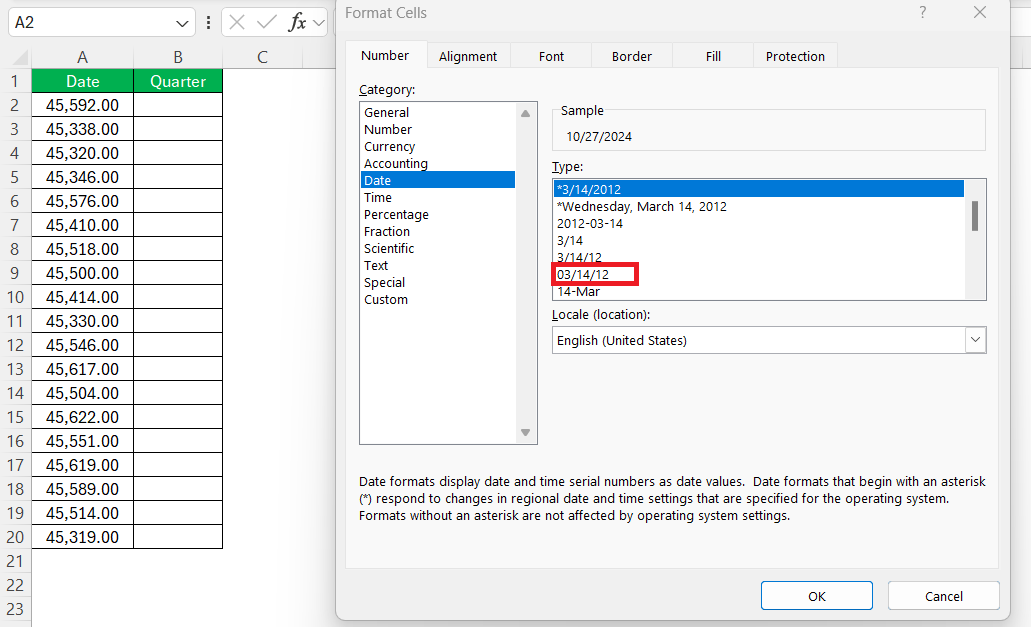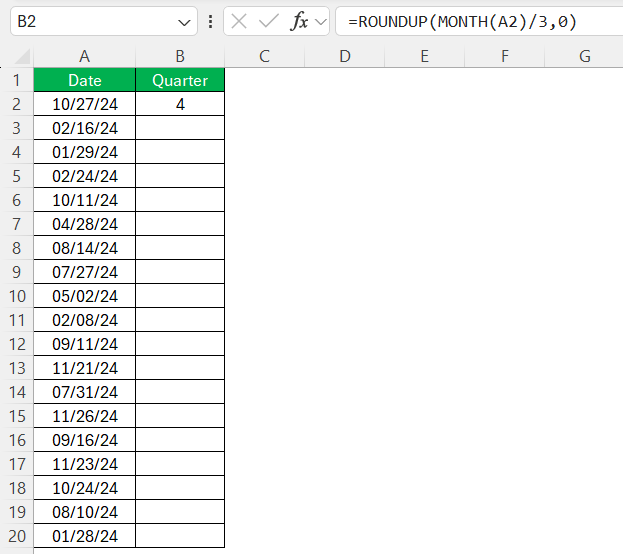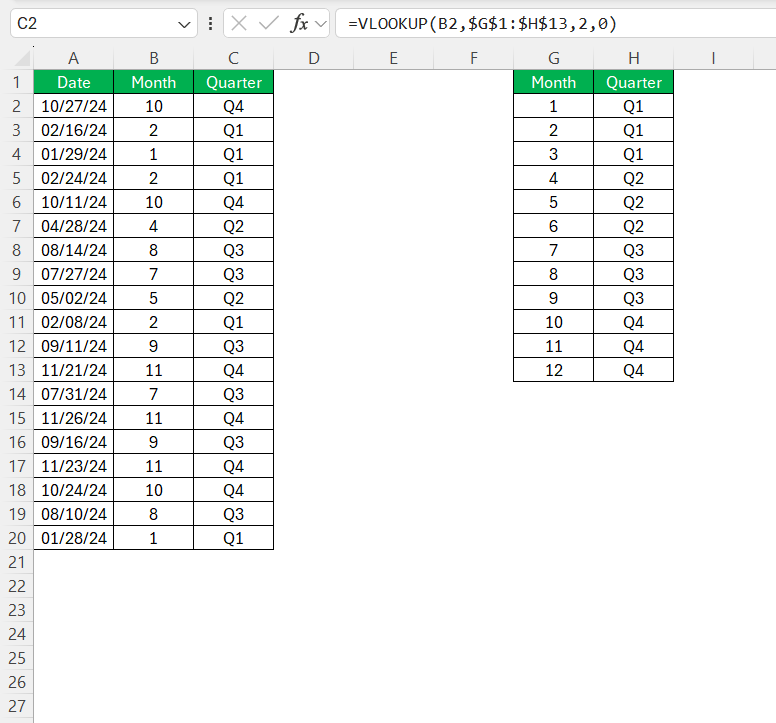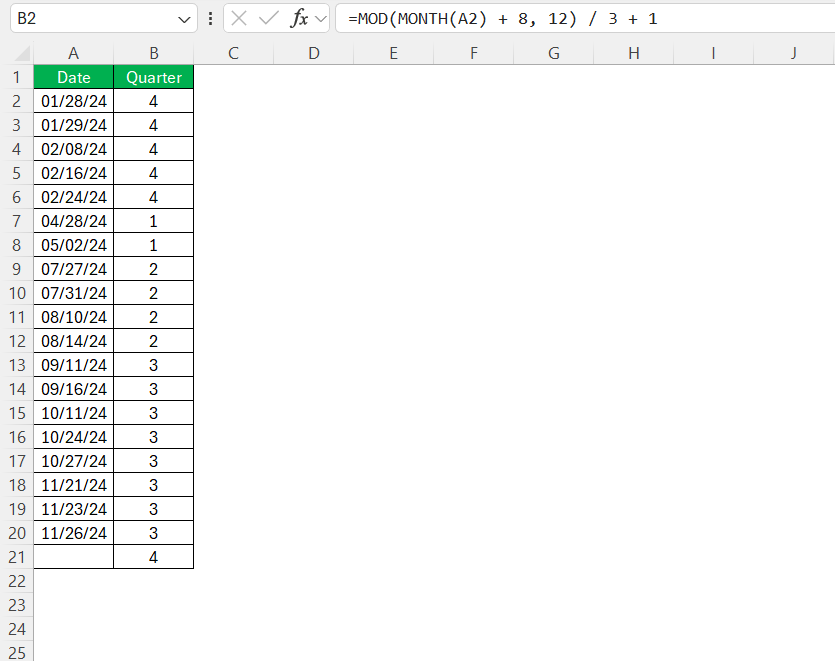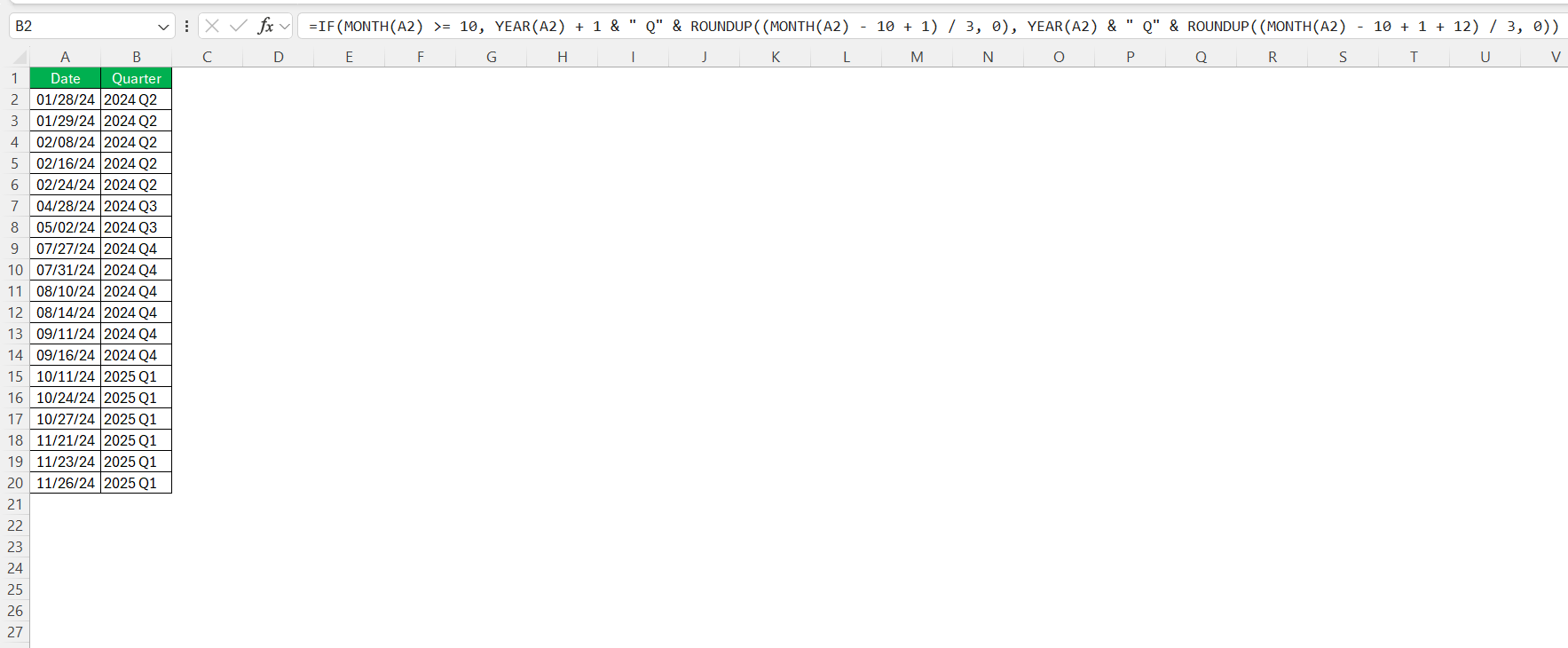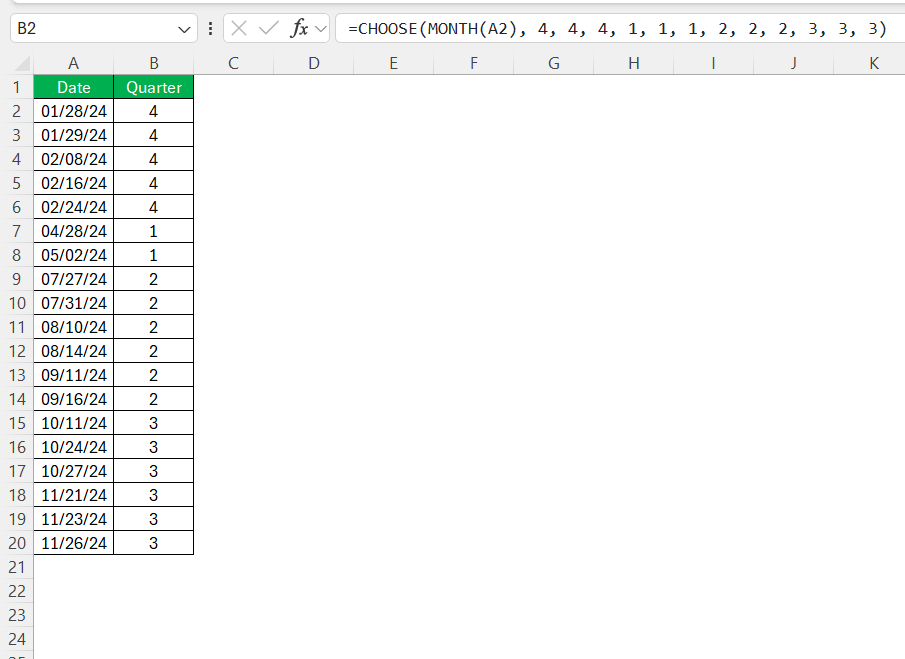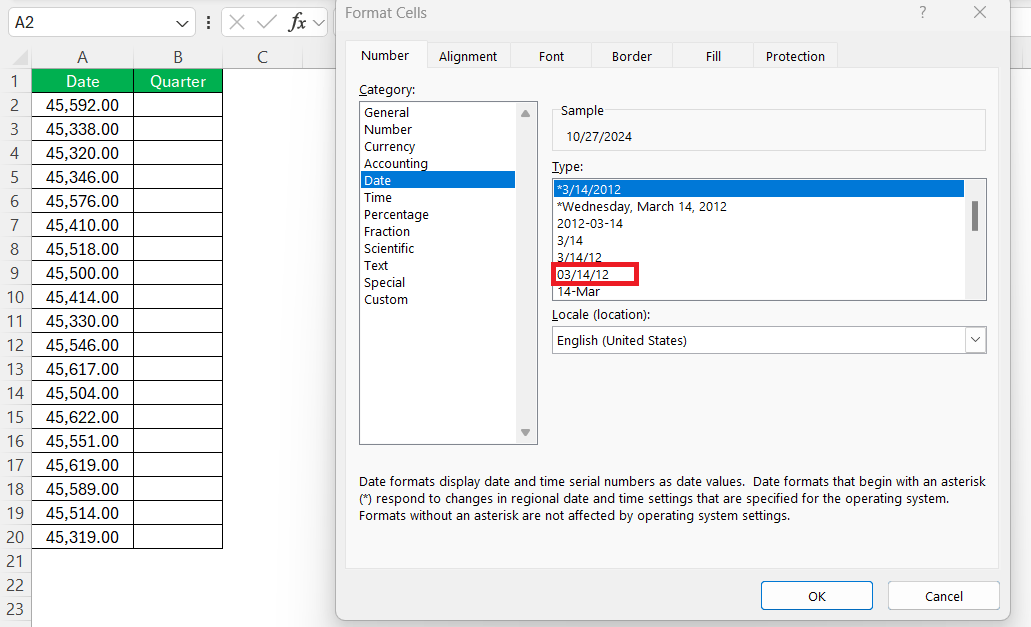Table of Contents
Introduction to Excel Date Formulas
The Relevance of Quarters
Grouping the dates into quarters can be useful in many ways:
- Many industries experience seasonality, so being able to track performance every quarter can be essential.
- It helps us understand how data behaves over specific time intervals.
- It can be useful in performing a quick comparison and providing meaningful insights.
- It helps in identifying trends that we may not be able to spot in monthly data.
- It can make financial and sales data more organized and consistent.
Using Excel for Date Functionality
Excel treats dates as number which makes date calculation in Excel very easy. You can add, subtract days, weeks, months, or years without having to use any complex formula. The common date functions are –
- MONTH – Extracts the month from a given date
- ROUND – Rounds numeric values
- MOD – Returns the remainder of a division
After using these functions, make sure to properly format the dates.
Convert Date to Quarter in Excel
Standard vs Fiscal Quarters
Quarters are often used in business and finance as they break down a year in 4 periods. This conversion can make a comparison easy and also help in trend analysis.
Standard calendar follows the regular January to December pattern, where Q1 covers January through March, Q2 April through June, and so on. The fiscal calendar is what an organization follows; they choose which month to treat as the start of the fiscal year. For example, if the fiscal year starts from April, the quarters will be – Q1 covers April through June, Q2 covers July through September, and so on.
Understanding this difference is vital when we use Excel for financial analysis, making sure that the data reflects the company’s actual operating period.
Set Up Your Excel Sheet
Before diving into formulas, it’s vital to properly set up the Excel sheet for accurate conversion of dates to quarters.
First, make sure that the dates are formatted properly and consistently. This will minimize the chance of mismatched data that could give incorrect results. To format the date value, select the value and press Ctrl + 1 to open the Format Cells dialog box. In the box, select Date and then choose the desired format.
Next, input the data in a tabular form with dates and their related values in separate columns. To convert data into a table, go to the Insert tab and select Table. This will make your data range dynamic and formulas will be applied to the new rows automatically.
A well-organized worksheet in data analysis helps you enable smooth quarter conversions and analysis.
Quick Methods to Get Quarters
Let’s break down the steps to quickly extract quarters from dates in Excel. The formula that can be used is
=ROUNDUP(MONTH(A2)/3,0)
- The MONTH formula will return the month of the date mentioned in cell A2.
- Then, the formula will divide it by 3
- Then, the ROUNDUP formula will round the value and return the next whole number.
You can also create a table with month and its quarter mentioned in separate columns. Then, you can use the VLOOKUP formula to get the correct quarter from the lookup table.
Advanced Techniques
Non-standard Fiscal Years
You can use Excel for calculations even when you have non standard fiscal year. You just need to make a custom formula to adjust the calendar. For example, if a fiscal year begins in April, you can change the calendar quarters accordingly by using a formula
=MOD(MONTH(A2) + 8, 12) / 3 + 1
- Use the MONTH formula to extract the month from the date
- Add 8 to shift the calendar and make it start from April.
- Use MOD to make the calendar go back to 1 after December
- Divide by 3 to group them into 4 quarters
- Adds 1 to convert the result into quarter numbers Q1–Q4.
Adding Fiscal Year Information to Quarters
It is important to include the fiscal year in your data, and it can improve your analysis. So, if the fiscal year starts from October, any date between October and December belongs to the 1st fiscal quarter and the next calendar year. You can use an IF check to check which fiscal year the date belongs to.
=IF(MONTH(A2) >= 10, YEAR(A2) + 1 & ” Q” & ROUNDUP((MONTH(A2) – 10 + 1) / 3, 0), YEAR(A2) & ” Q” & ROUNDUP((MONTH(A2) – 10 + 1 + 12) / 3, 0))
Tips & Tricks
Common Errors and Their Fixes
Below are some of the common mistake that can occur when calculating quarters in Excel –
- Incorrect Fiscal Year Start: A common error occurs if the fiscal year start date is set incorrectly. For example, if your fiscal year starts in April, use this formula to adjust the quarter based on the month in cell A2.
=CHOOSE(MONTH(A2), 4, 4, 4, 1, 1, 1, 2, 2, 2, 3, 3, 3)
- Mixed Date Formats: A dataset containing dates with different formats may create confusion, so it is important to keep a consistent format.
- Formula Errors: If your formula is incorrect, the result will also be incorrect. So, make sure to check your formula using Formula Auditing tools like Trace Precedents, Trace Dependents, Shwo Formula, Error Checking, etc.
Once you keep these mistakes in check, you can be sure that your data is accurate.
Best Practices
A few points should be kept in mind when working on quarter conversion in Excel:
- The input you provide should be current and updated regularly. Outdated data should be avoided as it may compromise the analysis.
- Use the TODAY formula to get the current quarter:
=IF(MONTH(TODAY())<=3, "Q1", IF(MONTH(TODAY())<=6, "Q2", IF(MONTH(TODAY())<=9, "Q3", "Q4")))
- Data Validation feature is needed to make sure that the input matches the criteria required and no unwanted or incorrect data is provided.
- When calculating fiscal quarters, you should make sure that the approach is uniform and consistent.
If you aim at employing these best practices diligently, the chances of error will be reduced, and you will have a more credible financial analysis.
FAQs
How to calculate quarters in Excel?
You can use ROUNDUP and MONTH functions to caluclate quarter from a date. If the date is mentioned in cell A2, you can use this formula –
=ROUNDUP(MONTH(A2)/3,0)
How to convert a date to a fiscal quarter?
You can use an Excel formula to choose the fiscal start month. For example, if the fiscal start month is April, use =ROUNDUP((MONTH(A1)-3+12)/3, 0). You change the 3 to any other number to match the fiscal start month.
Can Excel differentiate between fiscal and calendar year quarters?
No, Excel cannot automatically distinguish between fiscal and calendar year quarters. You can use a formula to set the start month for the fiscal year and calculate the quarter correctly.
What are the common mistakes that can happen when calculating quarters?
The common mistakes that can happen are using an incorrect fiscal start month, using an incorrect date format, or using an incorrect formula. Make sure to always check the date format and formulas used.
How to group the dates by quarter in Excel?
You can follow the steps below to easily show quarterly data in Excel –
- You need to convert the data into a tabular format.
- You need to get the quarter from each date.
- You need to create a Pivot table from the data.
- Group the dates by quarters.
Once you have completed these steps, you will be able to produce a visual summary of data. This quarterly summary of data will be useful for trend analysis.
John Michaloudis is a former accountant and finance analyst at General Electric, a Microsoft MVP since 2020, an Amazon #1 bestselling author of 4 Microsoft Excel books and teacher of Microsoft Excel & Office over at his flagship MyExcelOnline Academy Online Course.

